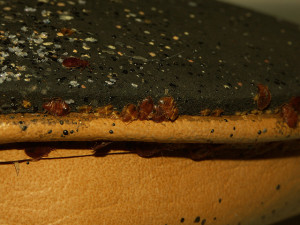What Are the Signs of Bed Bugs?
By Chris Williams on July 7, 2014.
People usually feel bed bugs before they ever see them. The first hint that something might be going on is when a person notices that they have a bite…or two. Still, many people will just shrug this off, figuring that they have mosquito bites or maybe even flea bites. It usually takes a few mornings of noticing new bites before an individual makes the connection, and has the stomach-churning realization that they might have bed bugs.
The reason we don’t see bed bugs is that they don’t want to be seen. They are very good at hiding in cracks and crevices and in dark, hidden areas. They also are active only at night (unless you have a really heavy infestation) and they hide during the day.
You can’t tell from the bites alone whether they are from bed bugs, or mosquitoes, or fleas, or chiggers, or spiders, or even dermatitis. People react differently to bed bug bites. Some have hardly any reaction at all; others who are more sensitized may have major swelling and itching from the bites.
How to Check Your Bedroom for Bed Bugs
Bed bugs range in color from straw (unfed) to dark red (fully engorged) and, fortunately, they are big enough to be seen. Immature bed bugs are smaller than a sesame seed; adult bed bugs can be the size of an apple seed. There are many photos of bed bugs, blood spots, eggs, etc. on the Internet. Check them out to help with your search. A flashlight and magnifying lens will also be helpful.
Below are some basic and quick ways to find evidence of bed bugs. A professional exterminator will do a much more thorough inspection. Note that these inspection tips work just as well when you are traveling and staying in a hotel or other lodging.
Check Your Bedding
Over several evenings of repeated bites, you will find tiny dark blood spots on your sheets or pillowcases. Some of the spots are digested blood from the anus of the bed bugs. Others are your own blood left when the bed bug withdraws its mouthparts. The blood spots look like dark red or brown spatters or smears.
Check the Rest of Your Bed
When not feeding on you, bed bugs spend much of their time hidden in your bed – in seams of the mattress, between the mattress and box spring, inside the box spring frame itself, and in cracks, crevices, and joints in the bed frame. Carefully pull the sheets off of the bed and look along the rolled seams of your mattress for blood spots, tiny white eggs, shed bed bug skins, and even live bed bugs. Continue checking other parts of the bed, including the corner joints of the bed frame and underneath the labels on the mattress and box spring.
Check Areas Near Your Bed
Bed bugs aren’t restricted to the bed; they commonly hide in areas near the bed. This part of the inspection can be as extensive as you want to make it but usually doesn’t have to move far beyond that portion of your bedroom. Check behind picture frames, headboards, baseboards, in electrical outlets, in bedside tables, in crevices of lamps and other furnishings next to the bed. Check curtains, decorative bed pillows, and any items stored under the bed.
By this point, you should know whether or not you have bed bugs. However, if you have a new infestation with only a couple of bed bugs, it may be very difficult to find them without professional help. If you find evidence of bed bugs, contact a professional pest control company. Bed bugs are one pest problem that you can’t treat successfully by yourself.
Photo credit: louento.pix / Foter / Creative Commons Attribution-NoDerivs 2.0 Generic (CC BY-ND 2.0)
